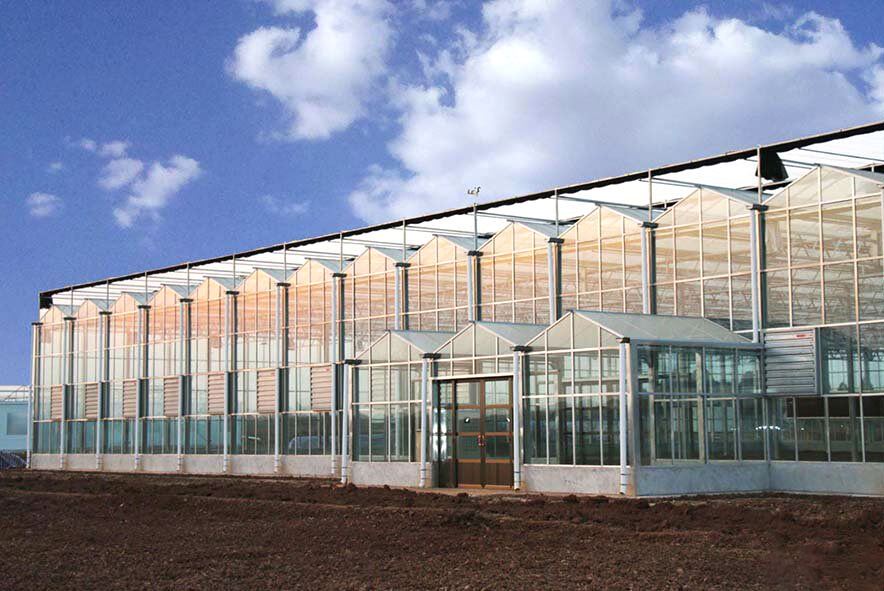Structural Design and Scalability for Commercial Greenhouses
Intended Use: Vegetable Growing vs. Floriculture and Design Implications
Greenhouses used for growing vegetables generally need higher vertical space, around 12 to 16 feet tall, because they have to accommodate trellis systems and machines that pick the crops automatically. Flower growers take a different approach altogether. They focus on getting the humidity just right and arrange their plants in multiple layers on benches. The ceilings there are typically between 8 and 10 feet high so the lights can spread evenly across those delicate flowers such as orchids and roses which need careful attention. When it comes to building strength requirements, tomato greenhouses actually need roofs that are about 30 percent sturdier than what's needed for flower houses. This extra reinforcement handles all the weight from ripe tomatoes hanging down after months of growth.
Freestanding vs. Gutter-Connected Structures for Efficiency and Expansion
Most commercial greenhouses today go with gutter-connected designs because they save about 18 to maybe even 22 percent more space compared to standalone units. This comes from sharing walls between sections and having one central climate control system for everything. A recent study by Harnois in 2024 showed that these connected setups can cut down on heating bills by around 30% in places with moderate climates. Plus, growers can expand their operations pretty easily, adding anywhere from 100 to 200 individual growing areas without much hassle. The whole thing works thanks to the modular truss framework which lets farmers just keep adding new sections whenever business picks up or when they need more room for different crops.
Roof Configurations (Venlo, Dome, Curved) and Their Impact on Light and Drainage
| Roof Type | Light Transmission | Drainage Efficiency | Ideal Use Cases |
|---|---|---|---|
| Venlo | 92% | Moderate | High-light vegetables |
| Dome | 84% | High | Seedlings & microgreens |
| Curved | 88% | Excellent | Heavy rainfall regions |
Venlo’s steep-angled glass panels maximize winter light capture, while curved polycarbonate roofs provide 35% faster rainwater runoff than flat alternatives—critical for preventing structural collapse in snow-prone areas.
Height Clearance and Structural Load for Equipment and Crop Growth
Modern commercial designs allocate 25—35% of vertical space for retractable lighting arrays, HVAC ductwork, and automated shading systems. Reinforced roof bars must support:
- 8—12 lbs/sq ft static equipment loads
- 6—10 lbs/sq ft dynamic crop weights (vine plants with mature fruit)
- 50 mph wind resistance in exposed locations
Greenhouse Size and Future Scalability for Commercial Operations
A 2024 survey of 112 commercial operators found that facilities designed with 20—30% unused utility capacity achieved 40% faster expansion timelines. Prospiant’s scalability guidelines emphasize centralized service corridors and standardized connection points, enabling growers to add 1-acre production blocks in 6—8 weeks without disrupting existing operations.
Covering Materials and Light Management in Commercial Greenhouses
Glass vs. Polycarbonate vs. Polyethylene: Durability, Cost, and Performance
The choice of covering material makes all the difference when it comes to how well a commercial greenhouse performs in terms of energy use, what kind of harvests farmers get, and ultimately how much money they spend running operations. Let's start with glass – it lets through around 90 to almost 95 percent of available light and can last upwards of thirty years if properly maintained. But there's a catch: greenhouses with glass need strong frames to hold them up, plus the upfront costs are pretty steep for most growers. Polycarbonate sheets strike a nice middle ground between lasting power (about 15 to maybe 20 years) and decent light spread across the growing area at roughly 80 to 90 percent. Farmers in areas where hail storms are common often go this route despite needing special mounting techniques because polycarbonate expands quite a bit when heated. Then we have polyethylene films which cost anywhere from fifteen to thirty cents per square foot, letting in about three quarters to nearly nine tenths of the sunlight. The downside? These films break down over time when exposed to UV rays and typically need replacing every three to five years depending on local climate conditions. According to research published last year in Frontiers in Energy Research, newer materials such as wavelength selective glass actually cut down yearly energy bills by somewhere between twelve and eighteen percent compared to traditional alternatives, although many growers still find these cutting edge solutions too expensive to implement widely.
Light Transmission and Diffusion Efficiency Across Glazing Options
Light diffusion quality varies significantly: double-layered polyethylene scatters 40—50% of incoming light, while prismatic polycarbonate achieves 60—70% diffusion uniformity. Crops such as lettuce thrive under diffuse light levels above 85%, whereas tomatoes benefit more from higher-intensity direct illumination.
Energy Efficiency Through Advanced Cladding and Insulation Systems
Multilayer cladding systems with air pockets or aerogel insulation reduce heat loss by 25—35% compared to single-pane glass. For example, a 2023 analysis of 12 commercial greenhouses showed that polycarbonate with integrated UV-blocking coatings lowered heating costs by $7.40/sq ft/year in cold climates.
Solawrap and Innovative Films for Enhanced Light Diffusion and Longevity
Polyethylene films featuring bubble technology now last between eight to ten years on average, all while keeping around 92 percent of light passing through them. The special design actually scatters light better, which boosts the amount of PAR reaching plants by somewhere between 18 and 22 percent when growing leafy vegetables. Some recent field tests showed that basil growers saw their harvests jump by about 14 percent simply by switching to these modified films, and they didn't need any extra energy for this improvement either. We're seeing more farms adopt these energy saving coverings that typically consume under half a kilowatt hour per square foot annually for temperature management. These materials have become pretty standard equipment across many agricultural operations, particularly where temperatures swing wildly from day to night.
Climate Control and Environmental Management for Optimal Yields
Integrated Climate Control: Balancing Temperature, Humidity, and Ventilation
Keeping temperatures within a tight range (around ±1.5°F), maintaining relative humidity between 50-70% for most plants, and ensuring proper air circulation are all critical factors for successful greenhouse farming. Modern greenhouses now use combinations of smart sensors along with AI controlled systems that constantly tweak environmental conditions as needed. This helps avoid problems like plant heat stress and stops mold from taking hold. Research indicates that when growers synchronize these different elements properly, vegetable yields typically jump anywhere from 20% to 28% over what's possible with traditional hands-on management methods.
Ventilation Strategies for Airflow and Disease Prevention
Cross-ventilation designs using roof vents and horizontal airflow fans minimize humidity pockets where pathogens develop. A 2023 Rutgers University study found that optimized airflow reduced Botrytis outbreaks by 34% and fungicide use by 22% annually among greenhouse tomato growers.
Heating Systems Compared: Gas, Electric, and Biomass for Commercial Use
- Gas boilers: Lowest upfront cost ($4.50/sq ft) but subject to volatile fuel pricing
- Electric heat pumps: 300—400% energy efficiency but require $8.20/sq ft infrastructure
- Biomass: Carbon-neutral operation with 12—15 year ROI; best suited for regions with access to wood waste
High-Tech Automation vs. Low-Energy Sustainable Climate Solutions
While automated CO₂ dosing systems and retractable shade screens optimize growing conditions, passive strategies like geothermal heating tubes or thermal battery walls can cut energy costs by 40—60%. The 2024 Controlled Environment Agriculture Report indicates hybrid systems combining automation and sustainability deliver the highest profit margins.
Precision Monitoring for Consistent Crop Growth and Resource Efficiency
Multi-spectral sensors paired with crop steering software enable millimeter-scale adjustments to irrigation and climate settings. This prevents the 13—17% yield fluctuations common in manually managed greenhouses and reduces water waste by up to 35% across 5-acre facilities.
Site Selection and Geographic Factors Influencing Greenhouse Success
Best Practices for Location and Site Preparation
Most greenhouse growers know that checking soil quality and leveling the ground before planting is essential work. About three quarters of greenhouses that thrive have proper drainage for heavy rain, around 2 inches per hour according to USDA data from last year. Location matters too when it comes to saving money on shipping products to market. Being near major roads or warehouses can slash transport expenses by roughly 15 to 20 percent. And don't forget about those pesky local rules either. Getting permits goes smoother when everything lines up with zoning laws. Looking ahead, most commercial operations need at least five acres if they want room to grow over time. The numbers back this up, with nearly nine out of ten businesses needing extra space eventually.
Regional Climate Considerations
The success of greenhouses really comes down to matching their construction specs to where they're located. Take subarctic areas for instance - these places need insulation that's about 40 percent thicker than what works in milder climates. Then there's the issue of hail damage. Greenhouses in regions hit by regular hailstorms end up spending around 30% more on replacing broken glass panels. And don't get me started on coastal greenhouses. Salt air eats away at materials so fast that growers have no choice but to invest in special corrosion resistant stuff just to keep humidity levels manageable. Speaking of extreme conditions, desert greenhouses are interesting cases too. When farmers install evaporative cooling systems instead of relying solely on natural airflow, they can actually drop those sweltering daytime temps by as much as 14 degrees Fahrenheit during heatwaves.
Sunlight Exposure and Orientation
Maximizing photosynthetic efficiency requires careful orientation planning. East-west alignment in northern latitudes captures 18% more winter sunlight than north-south configurations. Retractable shade systems maintain optimal PAR levels between 400—700 ¼moles/m²/sec during summer peaks, while light-diffusing glazing improves canopy penetration by 27% in vine crop trials.
Irrigation, Layout, and Crop-Specific System Integration
Precision Irrigation and Water Management for Commercial Efficiency
Commercial greenhouses today can get around 85 to 90 percent water efficiency thanks to drip irrigation systems that deliver water straight to plant roots. This beats the old flood irrigation methods hands down, which actually waste nearly half the water they use according to recent studies from the Agricultural Water Efficiency Report. Some growers have taken things even further with smart systems that include soil moisture sensors and weather prediction tech. These setups automatically adjust when and how much to water plants. The result? Farmers report cutting back on water usage by roughly 30 to 40 percent without hurting their crops at all. Makes sense really, since nobody wants to pay for wasted resources when there are better options available now.
Optimized Greenhouse Layout and Airflow for Maximum Productivity
Bench spacing aligned with prevailing wind patterns enhances natural ventilation by 25%, reducing reliance on mechanical fans. Vertical stacking increases planting density by 40% without compromising light access, while centralized aisles streamline workflow during harvest cycles.
Matching Crop Selection with Customized Growing Systems
Leafy greens perform best in shallow nutrient film technique (NFT) channels requiring 15—20 L/m²/day, whereas vine crops like tomatoes need recirculating hydroponic systems with targeted drip lines. Over 75% of berry producers now use adjustable gutter designs to accommodate seasonal growth patterns and mechanized harvesting.
Balancing Standardized Designs with Crop-Specific Customization Needs
Modular rail systems allow growers to reconfigure 60% of irrigation zones within 48 hours during crop rotations. Hybrid layouts combining fixed hydroponic tables with movable grow towers retain 80% of standardized construction’s cost advantages while enabling microclimate adjustments for specialty cultivars.
FAQ
What is the ideal greenhouse height for growing vegetables?
Greenhouses used for growing vegetables generally need higher vertical space, around 12 to 16 feet tall, to accommodate trellis systems and automatic crop-picking machines.
How do gutter-connected greenhouses benefit commercial growers?
Gutter-connected greenhouses save space, reduce heating bills by approximately 30%, and allow easy expansion, which is highly beneficial for commercial growers.
Which roofing type offers the best drainage efficiency?
Curved roofs offer excellent drainage efficiency, particularly essential in regions with heavy rainfall.
What are common covering materials for greenhouses, and how do they perform?
Common covering materials include glass, polycarbonate, and polyethylene, each offering different levels of durability, light transmission, and cost.
How do smart climate control systems improve yield in greenhouses?
Smart systems using AI and sensors maintain optimal environmental conditions, avoiding heat stress and mold, leading to yield increases between 20% and 28%.
What are the benefits of precision irrigation in commercial greenhouses?
Precision irrigation improves water efficiency to 85-90% and can reduce water usage by 30-40% without negatively affecting crops.
Table of Contents
-
Structural Design and Scalability for Commercial Greenhouses
- Intended Use: Vegetable Growing vs. Floriculture and Design Implications
- Freestanding vs. Gutter-Connected Structures for Efficiency and Expansion
- Roof Configurations (Venlo, Dome, Curved) and Their Impact on Light and Drainage
- Height Clearance and Structural Load for Equipment and Crop Growth
- Greenhouse Size and Future Scalability for Commercial Operations
- Covering Materials and Light Management in Commercial Greenhouses
-
Climate Control and Environmental Management for Optimal Yields
- Integrated Climate Control: Balancing Temperature, Humidity, and Ventilation
- Ventilation Strategies for Airflow and Disease Prevention
- Heating Systems Compared: Gas, Electric, and Biomass for Commercial Use
- High-Tech Automation vs. Low-Energy Sustainable Climate Solutions
- Precision Monitoring for Consistent Crop Growth and Resource Efficiency
- Site Selection and Geographic Factors Influencing Greenhouse Success
- Best Practices for Location and Site Preparation
- Regional Climate Considerations
- Sunlight Exposure and Orientation
- Irrigation, Layout, and Crop-Specific System Integration
-
FAQ
- What is the ideal greenhouse height for growing vegetables?
- How do gutter-connected greenhouses benefit commercial growers?
- Which roofing type offers the best drainage efficiency?
- What are common covering materials for greenhouses, and how do they perform?
- How do smart climate control systems improve yield in greenhouses?
- What are the benefits of precision irrigation in commercial greenhouses?


